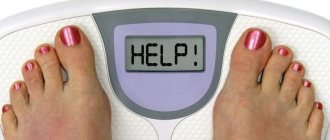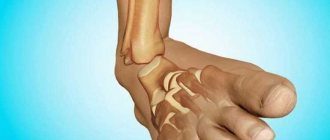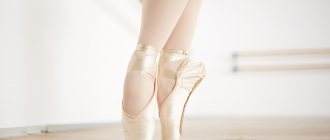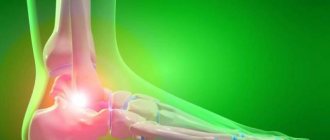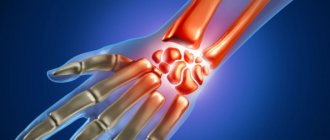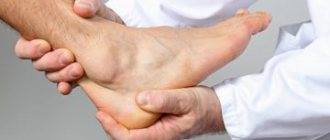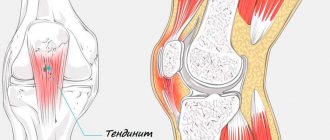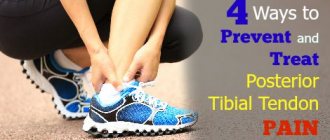Causes
More often than others, the problem is encountered by people who actively train, play sports professionally, or perform heavy physical work.
Since a rupture or sprain of the ligaments is always a consequence of increased load on the lower leg or foot, it is clear that it can be caused by:
- Obesity (with excess weight, the pressure on the limbs increases significantly, causing joints, ligaments, and tendons to suffer)
- High physical activity (jumping, running, fast walking on uneven surfaces, etc.)
- Lifting and carrying heavy objects.
- Wearing uncomfortable shoes (typical for women who prefer shoes with high thin heels or unstable wedges).
It has been noted that people with flat feet are at risk.
Risk factors and causes of pathology development
The disease in most cases develops in patients aged 20 to 45 years. Most often, physically busy people and drivers experience spinal distortion.
In addition, the following reasons can provoke the disease::
- sudden lifting of heavy objects, including when performing sports exercises;
- sudden braking of a vehicle and getting into an accident;
- sleeping on a high pillow and an overly soft surface;
- lack of physical activity;
- falling on your back, including from a small height;
- sharp turn of the body and neck;
- diseases of the spine, which reduces the strength of the ligaments.
Attention! In most cases, sudden braking of the car, even when secured with a belt, leads to distortion of the cervical spine. The complexity of injury in such a development of events depends on the speed of the vehicle; the higher it is, the greater the likelihood of a violation in the neck.
Consequences
Usually, after starting therapy and after it has been completed, the patient does not see or feel any negative consequences of distortion. But if prescribed recommendations are violated, there is no bed rest, or if the affected area is re-injured, the patient develops chronic pain in the head, neck and lower back . In some cases, distortion became an indirect cause of inflammatory processes and curvatures in the spine and chest.
Symptoms of the disease
With distortion there is no bone damage, but it can manifest itself in a similar way to a fracture. Most often, patients complain of:
- Severe pain at the site of injury.
- Swelling of the lower leg.
- Change in skin color in the stretched area - it becomes bluish or grayish, burgundy-red.
- Pain when pressing, inability to step on the affected leg.
Exactly what symptoms the patient will exhibit and how much they will bother him directly depend on the type of pathology. Doctors classify ankle distortion into three degrees:
- The first one . The leg swells, pain occurs both when feeling the joint and when trying to stand completely on the twisted leg, but it is not severe. The joint itself can function normally, that is, the patient can move the leg laterally.
- Second . In addition to swelling, local hemorrhage is observed. Its presence is indicated by a bluish tint to the skin. The pain on palpation is severe. A person cannot even move his foot in different directions or make subtle rotational movements. It's difficult for him to walk.
- Third . The joint area is very swollen. Hemorrhage affects not only the outer surface of the foot, but also the sole of the foot. The patient experiences sharp pain when lightly palpating the limb. In this form, the presence of a fracture is often mistakenly assumed. To make sure that the bone is intact, X-rays are taken.
General description of distortion
Spinal distortion is a minor or major injury to the spine . But unlike a bone fracture, possible dislocation, inflammation, or abrasion of bone tissue, distortion does not lead to serious disruptions in the functioning of the spinal cord or displacement of the vertebrae.
Most often, severe pain of a constant nature makes a patient suspect a developing disease. Pain is caused by damage to the spinal ligaments, which can be torn or completely torn.
Distortion does not have a specific code in the international classification ICD-10, as it occurs as a result of injuries to the spine or neck.
Distortion accounts for approximately a third of the total number of registered back and spinal injuries, while men and women suffer from this pathology equally often. Distortion is recorded in most cases in the neck area, but in some cases in the chest and lower back areas.
Distortion accounts for 15-25% of all spinal injuries
In addition to dividing the disease into cervical, thoracic or lumbar distortion, experts also distinguish:
- direct, with such distortion the impact goes directly to the spinal column due to sharp turns, bending or other movements;
- indirect, with such distortion the ligaments suffer due to falls or impacts.
Attention! The nature of the disease does not play a significant role in prescribing therapy. Direct and indirect distortion manifest themselves in the same way and require the same type of treatment.
Diagnostics
Only a qualified traumatologist can make a correct diagnosis - distinguish the disease described from a fracture or dislocation. Typically, the doctor determines the extent of the damage by palpating and visually examining the injured limb. However, in some cases (if there is severe hemorrhage, swelling, the patient cannot step on the leg), it is not possible to do without an X-ray or an MRI.
Symptoms and diagnostic methods
A traumatologist may suspect a diagnosis of “distortion” after palpation and a collected history of the patient’s complaints. But at the same time, a number of additional diagnostic procedures must be carried out.
| Survey | Character |
| Patient examination | Allows you to determine the real mobility of the injured area, the presence of redness and swelling. |
| X-ray | It is required to exclude fractures and cracks, which does not happen with distortion. |
| MRI | Makes it possible to check the integrity of the ligaments, the presence of their tears and possible fractures and dislocations. |
You should seek help from a traumatologist if there are characteristic signs of the formation of distortion in the patient:
- pain is constantly felt at the site of injury, which can spread along the entire spine or radiate to the head;
- in the damaged area there is difficulty in the mobility of the vertebrae;
- due to injury, swelling appears, there may be abrasions, scratches and other signs characteristic of injury;
- When palpating the affected area, the pain intensifies and is difficult to tolerate.
Attention! Even a seemingly insignificant injury to the neck or lower back in the presence of prolonged pain is a reason to contact a traumatologist. He will be able to exclude, confirm distortion or identify the exact cause of the disorder and constant pain.
Video: “Spinal injuries: classification, symptoms, treatment”
Therapy for first-degree ankle distortion
For first degree disease the following are indicated:
- Applying a pressure bandage - you need to wear it for about two weeks.
- Use from the second day of warming ointments (Viprosan, Finalgon), homemade alcohol painkillers tinctures (based on medicinal herbs).
- Carrying out warming foot baths and light massage from the second day.
It is important that the patient follows medical recommendations and engages in exercise therapy.
Causes of spinal distortion
Potential causes of spinal distortion include the consequences of traumatic effects on the tendon, ligament and muscle apparatus. As a result of stretching, rupture or scar deformation of these tissues, they lose their functional abilities. This may lead to instability of the position of the vertebral bodies.
Other possible causes include:
- heavy physical labor associated with heavy lifting;
- sedentary work, during which static tension in the muscles of the neck and collar area is observed;
- lack of regular full-fledged physical education in order to strengthen the musculoskeletal system;
- degenerative dystrophic disease of the spine (osteochondrosis) and its consequences, such as intervertebral hernia and protrusion;
- poor posture and curvature of the spinal column (scoliosis, hyperlordosis, kyphoscoliosis, stoop, etc.);
- diseases of the hip and knee joints, causing a decrease in the length of the lower limb;
- infectious and inflammatory processes in the spinal column, which negatively affect the elasticity and functionality of soft and cartilaginous tissues.
Often, professional athletes and people involved in outdoor sports (volleyball, basketball, football, alpine skiing, etc.) suffer from spinal column distortion. The leading cause of instability of the position of the vertebral bodies is always excessive lability of the ligamentous, tendon and muscular apparatus.
Therapeutic measures for second and third degree damage
Distortion of the second and third degrees is usually treated according to one scenario:
- The patient applies a pressure bandage daily using an elastic bandage. Also, according to the decision of the traumatologist, a circular bandage can be applied, reaching the middle of the lower leg.
- To relieve pain, the patient is given injections of novocaine or lidocaine directly into the inflamed area. Injections are repeated every two to three days.
- Two to three times a day, rub the painful area with anti-inflammatory warming creams and ointments (Ibuprofen, Ketanov, Indomethacin, Diclofenac).
- Perform a foot massage.
With the diagnosis described, it makes sense to apply gels to the skin of the inflamed limb to enhance the outflow of venous blood. For example, Troxevasin . It will speed up the resorption of the hematoma and reduce local bruising. As soon as the pain decreases, the patient should begin doing therapeutic exercises.
If the ligaments are completely torn, surgery may be required.
Treatment of distortion
Medicines and physiotherapy
Did you know that...
Next fact
If distortion occurs, the specialist must prescribe painkillers, anti-inflammatory, and decongestant medications. Their effect is aimed at suppressing pain, swelling, spasms and restoring damaged ligaments.
The following drugs can be used for treatment:
Distortion is treated medicinally with non-steroidal painkillers, they are usually taken orally or applied to the damaged area, for example, Diclofenac, Meloxicam or Fastum Gel;- if the pain is unbearable, the doctor prescribes injections, Novocaine blockades are usually used;
- to relax muscles and relieve spasms, it is necessary to prescribe Tolperisone;
- gels and ointments such as Ketoprofen and Viprosal are used as external anti-inflammatory and warming agents;
- in the presence of severe swelling, it is recommended to apply L-lysine Escinat;
- in case of severe circulatory disorders, which can cause headaches, Actovegin should be used.
Electrotherapy and magnetic therapy must be prescribed at the same time as the medications . In the first case, tissue regeneration and blood flow are improved with the help of current, in the second - with the help of a magnetic field. Heat therapy, which improves blood circulation, enhances immunity and eliminates pain, shows good results.
In this case, the patient should be at rest most of the time, ideally keeping bed rest for at least one month.
Attention! To maintain bone and joint tissue, traumatologists also recommend the use of calcium supplements and B vitamins.
Surgical and orthopedic methods
In case of spinal distortion, the doctor may prescribe wearing a Shants collar. For spinal distortion, no surgical intervention is performed.
The disease is controlled by conservative methods and does not require surgery even with severe inflammation of the ligaments.
If the neck area is severely affected, the patient is prescribed to wear a Shants collar.
This collar makes it possible to fix the vertebrae and muscles in the correct position.
When wearing a Shants collar, sudden movements cannot be made, which eliminates accidental injuries and complications of the patient’s condition.
The device must be worn for at least two months.
Exercises and massage
These manipulations occupy a major place in the treatment of spinal distortion . Usually a massage is prescribed for the entire back and, without fail, the collar area. This way you can relieve spasms, improve blood circulation, and reduce pain.
Classic or acupressure massage can be used; the exact type is determined by the doctor and also carried out by a specialist. Treatment requires 10-20 procedures.
After the acute period of distortion has resolved, exercise therapy is prescribed two weeks later. You should do physical therapy in the morning and evening. Exercises are selected for each patient separately and are initially carried out under the supervision of a physiotherapist. The load is increased gradually, sudden movements are prohibited.
You can learn more about spinal injuries in the following articles:
- You can read about the treatment of bruises and other injuries to the tailbone at the link
- You can learn more about diagnosing a sacral fracture using x-rays and its treatment on the page
- To find out what to do if you have a spinal bruise, go here
- You will learn about the consequences of a spinal fracture in the next article.
- What are the symptoms of a sacral contusion and how long does it take to treat?
- Find out what rotational subluxation of the atlas is, follow this link
Traditional methods
Cabbage leaf
This method allows you to relieve swelling and eliminate the inflammatory process. To speed up tissue regeneration, you need to take a fresh cabbage leaf, beat it a little and apply it to the affected area. The plant is fixed in any convenient way. It should be worn for at least three hours, ideally applied overnight. Treatment can be continued for up to two weeks.
Spinal distortion can be treated at homeHealing ointment
To prepare the medicine, mix pork fat and crushed dry hop cones in equal proportions. Wear the ointment 1-3 times a day in a thin layer for one week. This combination of ingredients allows you to speed up healing and relieve swelling.
Sugar and onion
The drug is aimed at relieving the inflammatory process and restoring ligaments. To treat, you need to grind several onions into a paste and combine them with sugar. For 100 g of onion porridge, take 2 teaspoons of sugar. The resulting product is rubbed into the sore spot once a day for no more than two weeks.
Traditional methods of treatment for spinal distortion are used only in combination with massage, exercise therapy and traditional medicines. Monotherapy with home recipes is a direct path to constant pain in the affected area of the spine and head.
Prevention
Preventive measures to eliminate distortion in a patient are simple. Traumatic situations should be avoided, and if they occur, immediately consult a doctor. You should not lift heavy objects, especially if you do not know the correct technique for such manipulations. When traveling in a car, be sure to secure yourself with seat belts and avoid sudden braking. Sports activities should be carried out in compliance with technique and without overloading the spine.
Distortion of the lumbar spine
Very often, distortion of the lumbar spine is diagnosed - this is due to its mobility and the high shock-absorbing loads that are placed on it. Manifests itself in the form of constant clicking and crunching sounds when bending and turning the body. Unusual physical activity may cause a dull pain that goes away after a long rest.
With a pronounced degree of distortion in the lumbar region, spinal canal stenosis may occur. This leads to disruption of the internal organs of the abdominal cavity. Prolonged constipation occurs, followed by diarrhea. Bladder dysfunction (incontinence or lack of urination) occurs. Women may experience secondary infertility, and men may experience erectile dysfunction.
Distortion of the thoracic spine
In most cases, distortion of the ligamentous-muscular apparatus of the thoracic spine develops after injury or against the background of deformation of the chest. This part of the spine has little mobility and flexibility due to the fact that the costal arches are attached here.
Acute distortion of the thoracic spine due to rib fractures or other displacement can provoke the development of pain. In scoliosis, distortion of the ligamentous apparatus of the thoracic spine develops gradually and does not give a clear clinical picture at the initial stage. Only with grade 3 scoliosis can a constant dull pain appear between the shoulder blades. There is a secondary violation of the position of the internal organs of the chest.
